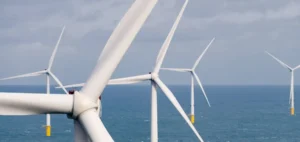Hywind Scotland, located off Peterhead, Scotland, is the world’s first floating offshore wind farm. In addition, the fleet is the best performing, achieving a capacity factor of 54% over its five years of operation. In addition, there were no accidents since 2017 due to compliance with safety standards.
With a capacity of 30MW generated by 5 turbines, Hywind Scotland uses the Hywind floating spar substructure concept. The wind farm generates enough electricity to power the equivalent of 34,000 British homes. Equinor is developing new opportunities to expand floating offshore wind energy worldwide.
Equinor’s next floating wind project, Hywind Tampen, delivered the first power earlier this fall. Once operational in 2023, Equinor will operate about half of the world’s total floating wind capacity. William Munn, plant manager of Hywind Scotland at Equinor, says:
“Operating the Hywind Scotland project over the past five years has informed Equinor of some of the unique challenges associated with a floating wind farm and the rewards if we succeed. Due to its location and the harsh weather conditions it encounters, Hywind Scotland is exposed to higher wind speeds than typically seen on a fixed-bottom wind farm, but must also withstand large waves, while still generating electricity with wave heights of 10 meters. Because of the environment, unique operation and maintenance methods were required, such as a high-performance crew transfer vessel (CTV) that can continue operations in higher-than-normal transfer conditions.”
A unique model
To maintain the wind farm, Equinor implemented a unique operation and maintenance (O&M) model. Indeed, it involves the upgrading of onshore wind technicians to maintain wind turbines in a floating offshore environment. Steinar Berge, head of floating wind at Equinor says:
“Equinor is the world’s most experienced floating wind operator and developer, and is building on the lessons learned from Hywind Scotland for global opportunities. We are moving forward with plans to develop additional projects in South Korea, Australia, France, Spain, California, the Celtic Sea in the UK and Norway. Hywind Scotland provides Equinor with strong confidence in floating offshore wind technology and allows us to advance even larger projects with a solid operational foundation, bringing us closer to the ultimate goal of industrializing and commercializing floating wind.”
Equinor is advancing the environmental initiatives of the Hywind Scotland project. Indeed, the company collaborates with the Scottish Government Directorate, Marine Scotland. The goal is to better understand how fishermen can operate safely around and in floating offshore wind farms.
Other initiatives include the installation of a stand-alone SailBuoy. The objective is to map the presence and quantity of fish with acoustic sensors. In addition, it would allow for the testing of a new method of environmental DNA (eDNA) analysis at Hywind Scotland.






















